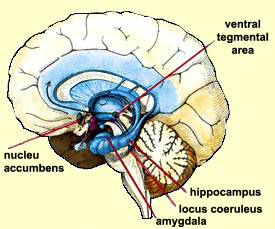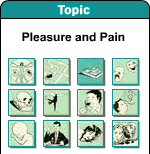|
|

The behaviours that the reward circuit drives us to repeat, as in the case of a drug dependency, can be reinforced positively or negatively.
In a positive reinforcement, the motivation for seeking the substance is the pleasure that it provides. In a negative reinforcement, the motivation is to relieve a physical discomfort, a depressive state, or social isolation.
Various theories explaining dependency behaviours posit that both types of reinforcement could be at play simultaneously to differing extents. |
|
|
| THE PLEASURE CENTRES AFFECTED BY DRUGS |
|
The
nucleus accumbens definitely plays a central role in the reward
circuit. Its operation is based chiefly on two essential neurotransmitters: dopamine,
which promotes desire, and serotonin,
whose effects include satiety and inhibition. Many animal studies
have shown that all drugs increase the production of dopamine in
the nucleus accumbens, while reducing that of serotonin.
But the nucleus accumbens does not work in isolation. It maintains close relations
with other centres involved in the mechanisms of pleasure, and in particular,
with the ventral tegmental area (VTA).
 |
|
Located in
the midbrain, at the top of the brainstem, the VTA is one of
the most primitive parts of the brain. It is the neurons of
the VTA that synthesize dopamine, which their axons then send
to the nucleus accumbens. The VTA is also influenced by endorphins
whose receptors are targeted by opiate drugs
such as heroin and morphine.
Another structure involved in pleasure mechanisms is the prefrontal
cortex, whose role in planning and motivating action
is well established. The prefrontal cortex is a significant
relay in the reward circuit and also is modulated by dopamine. |
The locus coeruleus, an alarm
centre of the brain and packed with norepinephrine, is another brain
structure that plays an important role in drug addiction. When stimulated
by a lack of the drug in question, the locus coeruleus drives the
addict to do anything necessary to obtain a fix.
Three structures in the limbic system also play an active part in
the pleasure circuit and, consequently, in drug dependency. The
first is the amygdala,
which imparts agreeable or disagreeable affective colorations to
perceptions.
The second is the hippocampus,
the foundation of memory, which preserves the agreeable memories
associated with taking the drug and, by association, all of the
details of the environment in which it is taken. Sometime in the
future, these details may reawaken the desire to take the drug and
perhaps contribute to recidivism in the patient.
The third structure, the most anterior portion
of the insular
cortex, or insula, is regarded as part of the limbic system
and is thought to possibly play a role in the active pleasure-seeking
associated both with food and with psychoactive substances. Damasio proposed that this part of the cortex tells us about the bodily
states associated with our emotional experiences. In this way, the
insula might also contribute to the conscious aspect of our needs
and desires.
But
the various drugs also act specifically on other areas of the brain.
|
|





